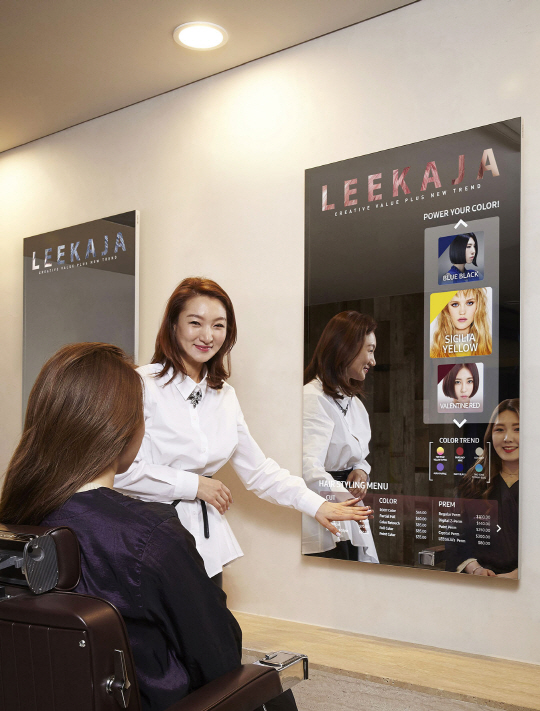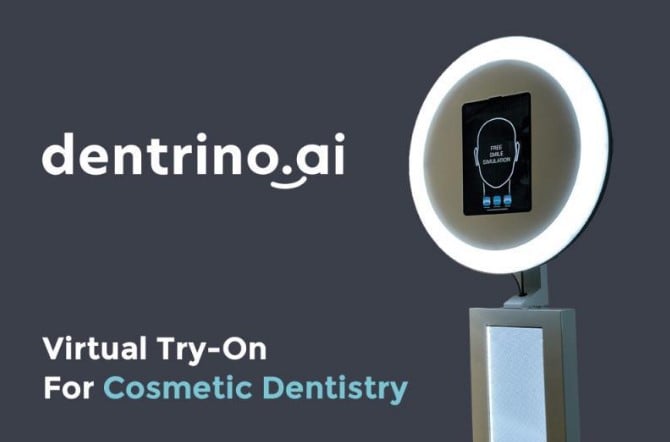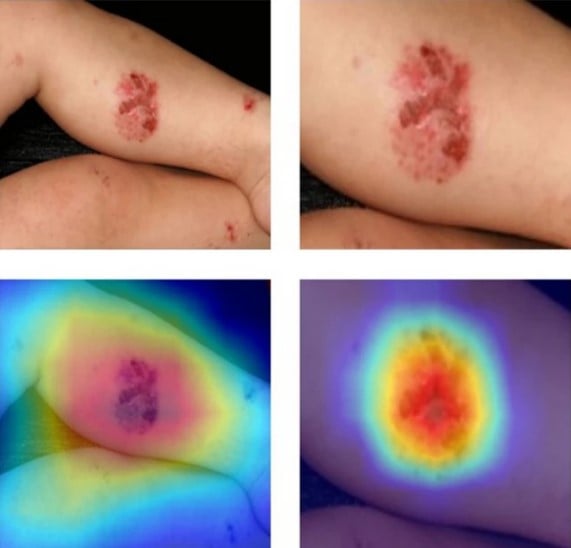Introduction
We have already discussed in many of our articles how AI can be of great help in industries such as biotechnology, medicine, or even the food industry. Perhaps this hasn’t occurred to you, but have you considered that AI can have applications in cosmetology as well? Keep scrolling to find out more!
Mirror, Mirror on the Wall
Let’s start with something fun. You want to change your hairstyle, but you aren’t sure if it will fit you. It doesn’t matter if it is a hair colour change or length shortening. You just aren’t positive that it will compliment your face and figure. You spend hours in front of your mirror trying to decide what style will make you drop-dead gorgeous. What a dilemma!
Now, we don’t want to sound extravagant, but there is a Computer Vision (CV) application to help you solve this Gordian knot. Before we get to that, we need to recall a technology that has gained great popularity lately, which is no other than ‘virtual try-ons’ with the help of Augmented Reality (AR), a subcategory of Extended Reality (XR). If you have ever shopped online, chances are that at least once you have encountered this in stores. A typical example is when buying glasses. No face is identical to another, and even though there is some standardisation, details matter. Slightly larger cheekbones, jawline, eye distance, etc. You get the idea. A virtual try-on assistant can help you decide if a pair of glasses will suit your face from the comfort of your home. But wait, we were talking about hair styling, right? Yes, and please, let us explain. As a pair of glasses is not just a tool, but also a fashion statement, so is hairstyle. You can probably imagine that such a technology can be applied to hair styling as well, but what if we took it a step further? Let us introduce you to the latest trend, the Internet of Things (IoT)-loaded smart mirrors.

Leading companies like Samsung are the usual suspects in this development, and the results are more than intuitive! Although this technology was first developed by professionals for professionals as a problem solver for a specific task, this doesn’t mean that you can’t have it at home. Edge Computing ensures that the local infrastructure can support the device, which can double as your daily driver mirror anyway, just on steroids. An attached camera will scan your facial characteristics and the GPU-accelerated AR algorithm will take care of the rest. Connecting to databases of manufacturers or retailers, this is as close as you can get to virtual try-ons without risking making a choice that is not 100% what you have in mind. Don’t be fooled that this is the limit. AR-driven virtual try-on algorithms are not limited to hairstyles and glasses, but the entire beauty industry! Make sure to check our Fashion & Beauty article to see how AI technology can revolutionise the fashion and makeup industries by giving even product recommendations. So next time you look in the mirror, think what such a simple piece of furniture can become if we enhance it with facial recognition.
Smile With Your Eyes
We took a sip of some commercial applications of advanced AI in cosmetology. That is, however, the tip of the iceberg. The term ‘cosmetology’ is a complex word composed of the Greek words ‘κοσμητικός, meaning ‘beautifying’, and the suffix ‘λογία’, meaning ‘the study of a field’. One of the most important elements of our appearance is our teeth; yet, they are often neglected. Here are four reasons why:
- Teeth affect our speech. If our teeth don’t match our mouth properly, our speech may sound slurred or unclear.
- Teeth can upgrade or downgrade a smile. A happy smile is one of the first things people notice about others!
- Teeth can reflect our overall health. Poor dental hygiene can cause serious health problems, such as severe gum disease and tooth decay.
- Teeth can boost our confidence. If someone has missing or crooked teeth, it can make them feel uncomfortable in social situations, potentially affecting their daily life.
Someone might argue that these are just cosmetic stuff and that true beauty comes from the inside. We are with you on that; however, consider the practical side as well. If someone is uncomfortable with how they look, many people will perceive this. It is all about what we project. Studies show that children can smile up to 400 times per day, happy adults 40 - 50, while typical adults approximately 20 times; thus, we need to make each smile count! (Dental Clinic in Delhi - Best Dentists in South Delhi, 2023)
Also, how many times have you had a toothache that made eating or speaking unbearable? Good luck finding a last-minute appointment with the dentist. Anyway, things can happen. Let’s suppose you visit the dentist’s office and decide to fix your teeth radically. Cases can range from simple dental cleaning, whitening, or braces to having removals or implants.
Flash me a Smile!
Technology surely advances and all branches, including the medical branch, need to keep up with it. The same CV technology used in the mirror described above can be used by dentists who want to make the most out of every procedure, leaving only happy patients. Smart mirror applications don’t end there, and some companies are living proof of that.
Meet dentrino.ai, the brand behind the ‘TOOTH BOOTH’, a virtual try-on photo booth for cosmetic dentistry. Dentrino.ai understands the power of a genuine smile, which led to the development of an AI-powered photo booth intended to be strategically placed in the waiting room. Their innovative system requires no training to use, nor does it require operation by a professional. You simply place your face inside the frame, and you can select from various whitening, orthodontic, and cosmetic simulations. The ToothBooth generates a unique simulation for every person, taking their individual situation and facial characteristics into account!
As a dentist you might have your clients coming over for regular cleaning, but wouldn’t you agree that a visual simulation would tempt your patients to spend an extra buck for your services? Definitely a great investment in marketing your services! If you still don’t want to place the ‘TOOTH BOOTH’ in your waiting room but like the idea, thankfully, dentrino.ai has excellent customer support offering a pay-per-use on-demand service. All you need to do is upload your patient’s full-face smiling photo!

Let me See
Moving to the dental chair, when you open your mouth, the dentist thoroughly looks at your oral cavity. To help them do that, many dentists use dental loupes that help them see every tiny detail. But they are only humans, and humans make mistakes. CV technology is here to ensure that these mistakes don’t happen. A properly trained algorithm could identify a multitude of conditions, such as dental abscess, gingivitis, periodontitis, bruxism, and caries. Or, maybe during the preparation for a dental filling, AR-loaded loupes could show the doctor exactly where and how to apply the filling material for optimal results. Not to mention that intraoral scanners could also benefit from CV. Yes, the ones dentists have now can work just fine, but wouldn’t it be better if they could automate the process after the scan? The dentist has to make an on-demand order for the components they need to treat the patient. An Edge Computing-backed IoT scanner could easily save time by ordering everything necessary for treatment.
Funny You Should Say That
And, of course, we all know how strange, yet funny, the way we speak with our mouth open while the dentist is fixing us. Dentists spend a lot of time in front of our faces, which can be uncomfortable for some people. To break the ice, they are usually very talkative, and only God knows how they understand what we tell them. Practice makes perfect, sure, but the struggle is real. How about, then, we improve the dental loupes by incorporating a Natural Language Processing (NLP) model into them? A well-trained NLP can be used as a human-machine means of interaction, which is more or less a sophisticated translator. All the funny sounds you make during this close-quarters conversation could actually be translated in real time using Generative AI for new dentists to understand, encouraging them to continue the conversation (at the patient’s cost) to make the time you sit in the chair more pleasant (supposedly).
Touch
The third and last section of this article is dedicated to an equally important aspect of our appearance, which can also act as an overall health indicator. For those who have not guessed it yet, we are talking about the skin! Moisturised, smooth, and glowy skin can not only be irresistible to look or feel but also shows that an individual’s overall health is at a great level. Skin conditions are very common. Take a moment to examine the table of the American Academy of Dermatology below:

There are so many skin care products out there, but sometimes something shows up that makes us worried. The first thing to do is to search online (BIG ‘no no’) and then book an appointment with the dermatologist. Although the literature on skin conditions is large, they can have alterations that can be difficult to identify. There are tools that can be used by both doctors and the patient for this, powered by the almighty CV. We introduce ‘digital dermatology’.

Smartphone cameras have become powerful nowadays, and processors are only getting better. Apps that use your camera loaded with CV algorithms could easily identify many abnormalities, such as acne, atopic dermatitis, melanoma, erythema, and ichthyosis. Of course, people have disbelief and would, most likely, not trust an app-made medical diagnosis, while at the same time an app cannot prescribe medicine. However, this does not mean that physicians can’t benefit from relative applications. Medical devices could be enhanced with such algorithms to provide physicians with important information instantly by comparing images of skin conditions to huge databases. Or, to combine the best of both worlds, a cloud-based application connecting the doctor and the patient could be the golden section. A patient can have an examination performed by a professional from the comfort of their home using technology that is already available to them. In other words, we are talking about telemedicine. If you want to learn more about telemedicine and the Internet of Medical Things, you can click here!
Summing Up
AI and machine learning algorithms have endless applications and can be a worthy addition to the field of cosmetology. It can have purely cosmetic applications, such as suggesting a hairstyle or showing you how white or straight your teeth can be, but it can also be priceless in dermatology or dental applications with a purely medical purpose. Training a general AI algorithm with enough data is its biggest limitation. Apart from that, AI is limited only by the imagination of developers.
What We Offer
At TechnoLynx, we like to innovate. We proudly say that we specialise in delivering tech solutions custom-tailored to your needs. The integration of AI into cosmetology applications is something we understand better than anyone while ensuring safety in human-machine interactions, managing and analysing large data sets, and addressing ethical considerations simultaneously.
Our software solutions are precise, with our main goal being the empowerment of a plethora of fields and industries using AI-driven algorithms. Innovating is our commitment, which drives us to adapt to the ever-evolving AI landscape. The solutions we present are designed to increase accuracy, efficiency, and productivity. Feel free to contact us and share your ideas or questions with us. We will be more than happy to take up your project!
List of references
- Bizwire, K. (2016) ‘Korean Hair Salon Introduces Smart Mirror’, Be Korea-savvy, 19 May. (Accessed: 23 March 2024).
- Dental Clinic in Delhi - Best Dentists in South Delhi (2023). (Accessed: 24 March 2024).
- Skin conditions by the numbers (no date). (Accessed: 24 March 2024).
- Smile Simulation (no date) Dentrino AI (Accessed: 23 March 2024).
- Son, H.M. et al. (2021) ‘AI-based localization and classification of skin disease with erythema’, Scientific Reports, 11(1), p. 5350.












